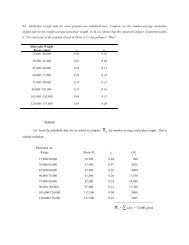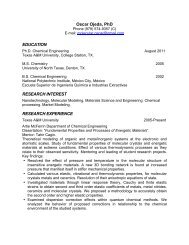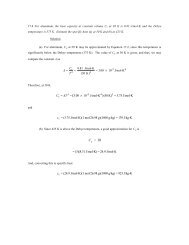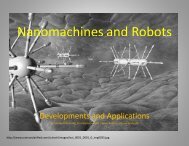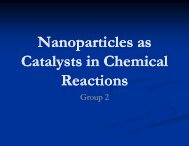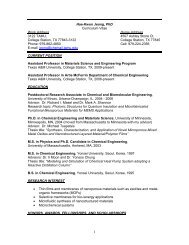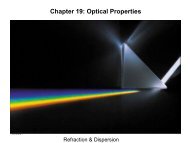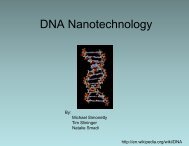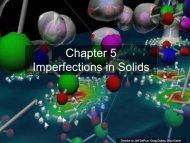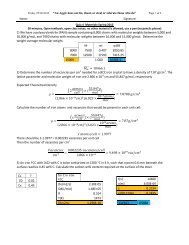SEMINARIO et al.: NANOCELL: CHEMICALLY ASSEMBLED MOLECULAR ELECTRONIC CIRCUIT 1617or interconnection of transistors with details smaller than theminimum feature size cannot be performed.A third and even more stringent problem limiting the designof faster IC is heat dissipation. <strong>The</strong> 1.1 cm 2 of a Pentium 4 diedissipates ∼115 W. This is why most of the weight of presentcomputers is due to the cooling and power supply systems.A further integration of devices would simply aggravate theproblem. <strong>The</strong> massive energy used to drive the 125 milliontransistors in the IC is the reason for the huge energy dissipation.A solution would be to use lower currents; however,the information is coded as current variations, as these currentvariations are used to process the information. Reducing theamount of current needed to code information would be a trivialsolution to the problem; however, such carrying signal currentscannot be too small because of the large signal-to-noise ratiosneeded for the detection of signals when they are transferredfrom device to device. <strong>The</strong> reader is directed to several recentstudies from different groups that have performed researches topredict and propose alternatives to the scaling-down problems[59]–[80].V. P OSSIBLE SOLUTIONS TO THE PHYSICALLIMITATION PROBLEMS<strong>The</strong> problem of miniaturization of electronic devices becauseof the physical limitation of integrating more devices in smallerareas could still be solved, leading to even better performances.<strong>The</strong> use of single molecules as electronic devices allows us tofabricate smaller devices. What is more; the incorporation ofmolecules into circuits has allowed us to combine the electricalcharacteristics with chemical reaction, i.e., to build sensors insizes that are comparable to single molecules. Single moleculescan be synthesized to precision in huge amounts (Avogadro’snumber). Circuits could be fabricated using biological techniques;the same way as proteins are fabricated in living beings.Although the fabrication of small molecules can be done, thepositioning and interconnection of these molecules become thebottleneck. Several chemical-based techniques such as selfassemblyand chemical deposition offer hopes to solve thisproblem.<strong>The</strong>re is a major hurdle associated with chemical or any othertechniques used to assemble molecules in a molecular circuit.<strong>The</strong> precision of the assembly is governed by statistical laws,which at atomistic scales do not allow the precise fabricationof molecular circuits, except when the devices are of the sizeof bulk devices. Thus, no two circuits fabricated to performthe same specific function have exactly the same conformation.Notice that this problem is beyond the scope of fault-toleranttechniques, as they are based on few nonfault-tolerant piecesthat are not available within atomistic size. This is perhapsthe major reason why the semiconductor industry that relies inperfect fabrication is not presently much interested in molecularelectronics as an alternative to semiconductor electronics.Heat dissipation is also a major issue in the present electronicsindustry. Perhaps a radical development is needed. Severalattempts to look for better materials and better heat dissipationtechniques are in progress, but they will just provide marginalimprovements in computational power. <strong>The</strong> problem is the wayFig. 2. Polarity of the MEPs for water. (a) Singlet or ground state. (b) Tripletor excited state. Although the regions around the nuclei show positive potential(blue), eventually infinite at the nuclei, the sites outside the molecule showpotential either positive (blue) or negative (red), depending upon how electronsare distributed around the molecule. Since the triplet state geometry is lessangular, the negative effect of the electrons can be seen on both sides of themolecule. Characteristics of water that make it a very unusual molecule are dueto its large dipole moment in the ground state.in which signals are coded in today’s electronic systems. Storedsignals are coded as charge, actually as charge separation to beprecise, and they are maintained by an external power supply.On the other hand, signals are coded as variations of currents,so they can be transmitted to all other devices requiring thesignal. <strong>The</strong> excitation of vibrational states is what produces thelarge dissipation. <strong>The</strong> larger the currents, the larger the energydissipated and converted into heat.Possible scenarios to reduce the heat dissipation by severalorders of magnitude include the coding of the information, notdirectly into the electrons but into other energy modes. Twopromising scenarios have been proposed: One is the use ofMEPs to code, detect, and process information, and the otheris the use of vibrational states to transfer information.<strong>The</strong> MEP is the potential V at any point r induced by allelectrons and nuclei of a molecular system. It is a well-definedquantity from the electron densityV (r) = ∑∫Z i|R i − r| −ρ(r ′ )|r − r ′ | dr′ .<strong>The</strong> density ρ(r) can be obtained directly from the wavefunctionof the molecule. As an example, the molecular potential of watercan be described in simple terms. Sites in the neighborhoodof the oxygen atom should be negative and sites around thehydrogen atoms should be positive due to the strong electronegativitydifference of these atoms [81]. Fig. 2 shows the MEP forwater, distinguishing the sites of positive potential (blue) fromthe sites of negative potential (red). <strong>The</strong> corresponding MEPfor the triplet excited state of water is also shown. Thus, strictlyspeaking, any molecule or atom could be used as a memory. Inthe case of water, we could simply read the potential on the sideof the hydrogen and check whether it is positive or negative.Making a molecular logic gate operating with electrostaticpotentials is not difficult either [17], [82]–[84]. A simple oneimplemented using trifluorobenzene is shown in Fig. 3. <strong>The</strong>molecule trifluorobenzene is excited in this case by the MEPof two water molecules conveniently located, whose orientationyield the four possible inputs. Notice that these water molecules
1618 <strong>IEEE</strong> SENSORS JOURNAL, VOL. 6, NO. 6, DECEMBER 2006Fig. 3. (a)–(c) Implementation of a logical AND using a tri-flourobenzene molecule using positive logic. <strong>The</strong> negative regions (red) correspond to a logical“zero” and the positive regions (blue) to a logical “one” at the output, indicated by the arrow at the right of the isolated hydrogen atom. <strong>The</strong> inputs are providedfrom the positive (white for the hydrogen) or negative (red for the oxygen) sides of the water molecule, and the output is taken on the right side of the isolatedhydrogen atom (white). <strong>The</strong> 00, 10, 11 inputs to the gate are shown, respectively. (d) Case for the 00 inputs, indicating the range of voltages (color coded)by the bar at the bottom. <strong>The</strong> other two cases have similar range of voltages. Notice that the potential at the nuclei is extremely large (and positive); however,those regions are not accessible by molecule–molecule interactions and are also chemically irrelevant. Carbon atoms are in green, fluorine in grey, and hydrogenin white.are used only as the sources applied to the inputs; they arenot part of the molecular gate. Simply, thanks to the dipolarnature of water, we can use the oxygen (negative) side as a“zero” input and the hydrogen side (positive) as a “one” inputto the molecular gate. We could use any other source that yieldspositive and negative potentials. In this case, we decided to usea molecular source for the sake of compatibility. Thus, Fig. 3(a)shows the 00 inputs yielding zero at the output; Fig. 3(b) showsthe 01 inputs, which is equivalent by symmetry to the 10,yielding zero; and Fig. 3(c) shows the 11 inputs yielding one.<strong>The</strong>se tests prove unambiguously that the molecule performs asa logical AND. It responds to the following truth table:V 1 V 2 V 00 0 00 1 01 0 01 1 1Interestingly, the energy needed to excite the molecule withthe two inputs is less than 0.5 eV [17]. This implies that it may.be possible to operate 200 million of these gates at 10-GHzfrequency with less than 1 W. More precisely(2 × 10 8 gates)(10 10 operation/s)(0.5 eV/gate-operation)×(1.6 × 10 9 J/eV) =0.16 J/s =0.16 W.This is certainly a rough estimate, most likely within the sameorder of magnitude of the exact value. This estimation considersthe energy to change states of the gate and excite their inputs.As gates are directly interconnected, losses in interconnectionsare perhaps a small fraction of the energy to change states.Nevertheless, even an error of one or two orders of magnitude,underestimating the power consumption, still represents anexcellent result. Using a similar logic to calculate the powerneeded in the modern Pentium XE and assuming a gate capacitanceof 40 aF, it amazingly yields 125 W (most likely a luckymatch), to which we need to consider the energy dissipation inthe interconnects, the energy needed to change the input states,and the utilization factor among others; all these should accountfor the total 130-W dissipation in the microprocessor.When comparing molecular devices to their microelectroniccounterparts, the question of gain is always a concern. However,
- Page 1 and 2: 1614 IEEE SENSORS JOURNAL, VOL. 6,
- Page 3: 1616 IEEE SENSORS JOURNAL, VOL. 6,
- Page 7 and 8: 1620 IEEE SENSORS JOURNAL, VOL. 6,
- Page 9 and 10: 1622 IEEE SENSORS JOURNAL, VOL. 6,
- Page 11 and 12: 1624 IEEE SENSORS JOURNAL, VOL. 6,
- Page 13: 1626 IEEE SENSORS JOURNAL, VOL. 6,




